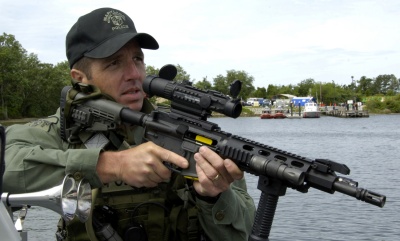
Sgt. Mel Adam of the Maryland National Resource Police keeps an eye on his crew as they board a vessel with chemical contamination during an exercise Wednesday at Coast Guard Station St. Inigoes. Adam was one of many players involved in the exercise Joint Venture. (Coast Guard photo by Petty Officer 3rd Class Ayla Stevens.)
By Ayla Stevens
ST. INIGOES, Md. (May 31, 2008)—Two vessels took refuge in the Patuxent River as hurricane Zoe slammed the Eastern Shore communities with category four winds in early May. Days after the storm, residents of St. Inigoes, Md., began to take notice of the odd traffic coming to and from the vessels, especially at night. Concerned citizens decided to contact the Coast Guard after one of the vessels began to leak what appeared to be oil or diesel into the water. A Coast Guard boat crew from Station St. Inigoes is deployed to investigate the report.
As the Coast Guard boat pulls up to the vessel, a male passenger enters the cabin and secures all entrances. The crew is eventually able to talk the man out of the cabin, but due to his erratic behavior, he is detained for further questioning. During the interview, it is discovered that one of the boats is without state registration and the man had stolen the other boat.
As the crew steps aboard the second vessel, they begin to experience symptoms of dizziness, nausea and shortness of breath. When they look inside, they see what appears to be an operating methamphetamine production lab. Now what?
The scenario above is false, but the dangers faced by maritime first responders are real. May 27, 2008 marks the beginning of the first three-day joint agency field exercise that involved multiple response missions for federal, local and state agencies in Maryland . During most exercises, agencies will come together to work on one mission using their specific specialties. Operation Joint Venture provided an opportunity for numerous agencies to come together to work on multiple missions.
The U.S. Coast Guard, Coast Guard Auxiliary, Maryland National Guard 32nd Civil Support Team (CST), Maryland National Resource Police (MNRP), state police, Calvert County Sheriff Department, Maryland Tactical Operations Group (MTOG), National Oceanic and Atmospheric Administration and Miller Environmental Group were all working together to perform law enforcement, oil spill clean up and tactics in responding to a hazardous chemical contamination site.
“[We want] to see how we all the different groups function together, because we don’t always bring all the capability to the table,” said Lt. Josh Blocker, an incident command chief for the Coast Guard.
The first day consisted of setting up the scenario and getting the players set-up and ready to go. The Coast Guard Auxiliary brought two of their boats and anchored them just outside from Station St. Inigoes to act as the suspect vessels. Injects of information came throughout the day notifying players in the exercise of what was happening so they could begin the proper processes of reaction.
The second day was play day; the unified command of agencies came up with a plan of action and executed it. The MTOG boarded the the vessel to remove the Coast Guard crew that had become overwhelmed by the powerful fumes from the meth lab and detained two suspects from the vessel. Members of Station St. Inigoes played the two suspects who were actually put into zip tie cuffs and escorted off the boat.
The boarding team from MTOG, the Coast Guard crew and suspects were transported to a decontamination site ran by the 32nd CST and then sent to the hospital.
After a lunch break, the exercise went back into action. Simulating that the area was secure and that the vessel had been towed to a Coast Guard pier.The 32nd CST put on their biohazard suits and went aboard to take samples and run tests on the chemicals used in the meth lab. Simultaneously, Miller Environmental Group deployed a boom around the other vessel and began the clean up and recovery operations for the released diesel.
The last day was used to break down the actions taken the day before in discussion. The agencies provided feedback on what they thought went well, what didn’t, and what could be done differently.
“For what went into it and what we got out of it, it went really well,” said Blocker. “We met our goals.”
This exercise was not designed to just see how the job is done, but to provide training in working with other agencies and learning about their specialties. The goal was to use each others expertise to there full advantage and to develop some lessons learned so agencies will know what capabilities they bring to the table in the event something really did happen. The agencies involved are looking forward to opportunities in the future to do more drills of a multi-mission nature.
Source: U.S. Coast Guard


